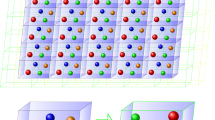Abstract
Recently, the amorphous state of matter, which can be regarded as an excited state in relation to the crystalline state, has become of interest. This state is formed from the liquid state by certain rapid cooling techniques, and thus manifests a wide spectrum of controllable structural modifications and physical parameters. It may be said that just like a liquid, an amorphous solid consists of a collection of defects with a certain characteristic viscosity. According to [1], the “defect nature” of amorphous solids as compared to crystals manifests itself by at least two methods: a) rapid cooling leads to identical groups of atoms being able to occupy slightly differing energy positions in the amorphous matrix in the absence of any extraneous impurities; b) divergence in potential energy of identical atomic groups is produced by extraneous impurites. In [1] it was established that a type a) system has strong quasispin-phonon interaction, while type b) systems do not affect attenuation of sound, but both produce a contribution to heat capacity at low temperature (10−2−10°K).
Similar content being viewed by others
Literature cited
S. Hunklinger, L. Piche, J. C. Lasjaunias, and K. Dransfeld, J. Phys. C: Sol. State Phys.,8, L423 (1975).
P. W. Anderson, C. Varma, and B. Halperin, Phil. Mag.,25, 1 (1972).
K. K. Mon, Y. J. Chabal, and A. J. Sievers, Phys. Rev. Lett.,35, 1352 (1975).
M. Rubinstein and P. C. Taylor, Phys. Rev.,B9, 4258 (1974).
J. Szeftel and H. Alloul, Phys. Rev. Lett.,34, 380 (1975).
S. R. Nagel and J. Tauc, Phys. Rev. Lett.,35, 380 (1975).
N. Heiman and K. Lee, Phys. Rev. Lett.,33, 778 (1974).
M. Dutoit and H. S. Chen, Appl. Phys. Lett.,23, 221 (1973).
R. W. Cochrane, R. Harris, J. O. Ström-Olson, and M. J. Zuckermann, Phys. Rev. Lett.,35, 676 (1975).
U. Kh. Kopvillem, Zh. Eksp. Teor. Fiz.,42, 1333 (1962); Izv. Akad. Nauk SSSR, Ser. Fiz.,37, 2010 (1973).
J. Joffrin and A. Levelut, J. Phys. (Paris),36, 811 (1975).
A. V. Alekseev, U. Kh. Kopvillem, V. R. Nagibarov, and M. I. Pirozhkov, Zh. Eksp. Teor. Fiz.,55, 1852 (1968).
G. M. Ershov and U. Kh. Kopvillem, Radiospectrocopy [in Russian], No. 8, Izd. Perm'. Univ., Perm' (1974), p. 55.
U. Kh. Kopvillem and V. D. Koperanov, VINITI, No. 4437-72 (1972).
K. S. Liang, A. Bienenstock, and C. W. Bates, Phys. Rev.,B10, 1528 (1974).
U. Kh. Kopvillem, V. N. Osipov, B. P. Smolyakov, and R. Z. Sharipov, Usp. Fiz. Nauk,105, 767 (1971).
W. Arnold and S. Hunklinger, Solid State Commun.,17, 883 (1975).
Author information
Authors and Affiliations
Additional information
Translated from Izvestiya Vysshikh Uchebnykh Zavedenii, Fizika, No. 7, pp. 69–75, July, 1977.
Rights and permissions
About this article
Cite this article
Kopvillem, U.K. Amorphous echo. Soviet Physics Journal 20, 892–897 (1977). https://doi.org/10.1007/BF00893135
Received:
Issue Date:
DOI: https://doi.org/10.1007/BF00893135




